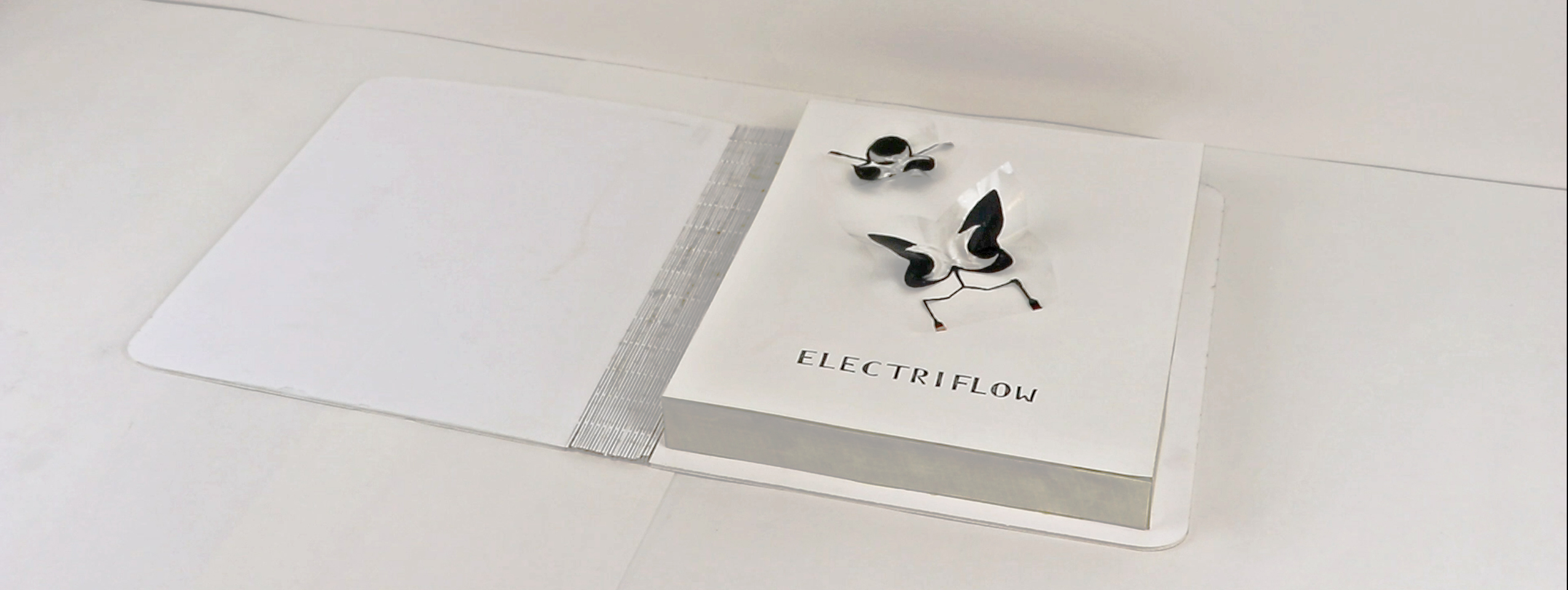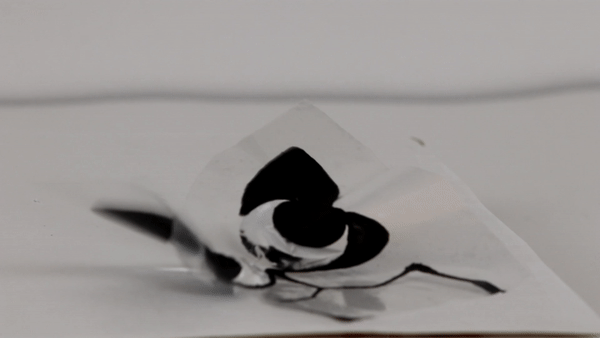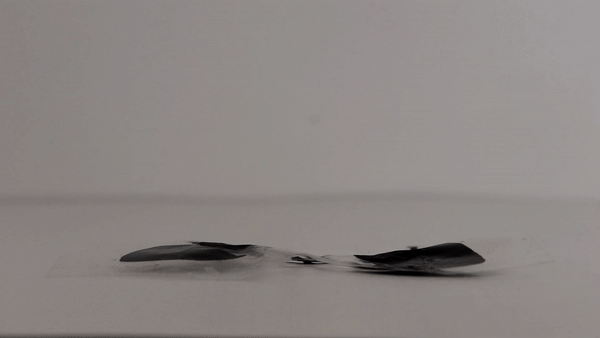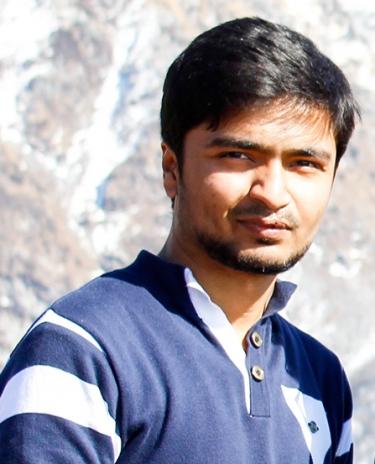Image Credit: © 2021 Purnendu
SIGGRAPH sat down with Purnendu, a Ph.D. student in the ATLAS Institute at the University of Colorado Boulder to talk about his team’s SIGGRAPH 2021 Labs project, “Electriflow: Augmenting Books With Tangible Animation Using Soft Electrohydraulic Actuators.” Their actuator technology strives to augment animation within physical books. Read on to learn more about the project and what it means for the future of books.
SIGGRAPH: Tell us about the process of developing “Electriflow.” What inspired your team to pursue this project?
Purnendu (P): I am a Ph.D. student in the interdisciplinary ATLAS Institute at the University of Colorado Boulder, and it is a very radical and crazy place. There are people from very diverse backgrounds doing all sorts of work. I remember, almost two years back, there was a workshop on origami, which is the art of paper folding. In the workshop, the question came up: “Can you animate those paper folds?” What technologies would you use to do this? We had already seen the basics of these soft, electrohydraulic actuators from Christoph Keplinger, our collaborator, so the idea started there. At the time, we were not sure how it would progress. We had that goal to make a book, but, like most research, it was like building a bridge. You start at two ends, and you keep building until you meet in the middle. We never really knew where it would go. Some advantages of these actuators was that the form factor was really compact, it used silent operation, and it had speed behind it. These three factors were the primary motivation that steered us toward using actuators and toward our final research presentation.
SIGGRAPH: How do you see this research changing digital books (e-books) or audiobooks in the future?
P: Our goal idea was to augment the experience of books by making them more expressive or interactive. We believe that the technology right now could become a really good thing for children’s books. Imagine you have a children’s book about butterflies. This technology allows the book to not just be visual, but when you open the pages the butterfly can flap its wings. You can even compare different butterfly species based on the speed of the wings. It completely changes the experience for the child. In the long-term, it would be nice to build more sophisticated structures and more complex shape-changing within this idea. I believe people will be more drawn to physical books as this technology develops.
SIGGRAPH: Did you consult with publishers in developing the tech?
P: We didn’t explicitly consult with publishers during development but it is something we have considered and something we have in mind for the future.
SIGGRAPH: SIGGRAPH Labs sessions are meant to be interactive, hands-on classes. What was most exciting about your Labs project for SIGGRAPH 2021 participants and why?
P: I would say SIGGRAPH Labs sessions are a great venue to showcase your project because the audience is from a very diverse background. This time it was virtual, which was kind of a bummer. It would have been great for people to have the opportunity to feel it, try it, and see how it looks. However, we are excited for people to have the chance to interact in-person this year and to see the [new] SIGGRAPH Labs projects.
[In 2021,] there was a lot of excitement among participants, specifically around the compactness and the speed of these actuators. A lot of people said they had never seen anything like it before. To give some perspective, a normal butterfly can actuate their wings at around 26.1 hertz; our actuators can operate at 25 hertz. The technology is very close to what butterflies can actually do. The idea that this can be embedded into a book — and make books more dynamic — made people excited and they could see a lot of potential from our project.
SIGGRAPH: What is a key technique you hope participants from your Labs class brought back to the office?
P: Our Labs session was more like a showcase for the project, but we do have a detailed publication for this project. In the publication, we proposed a software for people to try out using these actuators and make something of their own. There was a lot of excitement around that. We want to work toward democratization of this actuator technology, especially for the research and designer communities. This publication gave them one extra element in their toolkit to use.
SIGGRAPH: Did you come across any specific difficulties in the making of this project?
P: Of course — a lot. To begin with, these actuators are oil-filled pouches and they have carbon paint on both ends and high voltages (the size of an iPhone battery, for example). I do want to point out that these are very safe and non-lethal. You can build high-voltage circuits that are safe and we did just that. That being said, our first challenge was making these pouches so that they don’t fail and they operate correctly. We also tailored our project around which geometric shapes were the safest, so designing and coming up with the geometric shapes posed a challenge as well. With every challenge, we began by trial-and-error, and gradually incorporated all of our learnings into the software we created that hopefully makes it easier for others to use. For anyone working to create actuators, like with any project, give it time and you will get better.
SIGGRAPH: What is next for “Electriflow”? Can we expect to see more from these shape-changing interfaces in the future?
P: I would say that this is just the start for “Electriflow”. We want to create more shape-changing interfaces, including more expressive shapes and different shape-changing patterns. We hope to incorporate rotation, twisting, swirling, etc., and to add more programmability. My dream is that one day someone will be reading a comic book, let’s say “Tom & Jerry”, for example, and the characters can actually do a physical action in the book. I don’t want the book to only engage your visual and auditory senses, but also the physical. We are currently working in that direction and there are a lot of possibilities. We’ll see how it goes.
SIGGRAPH: What advice to you have for someone looking to teach in SIGGRAPH Labs during a future SIGGRAPH conference?
P: SIGGRAPH Labs is a great venue. When tailoring your project toward [the program], I would suggest focusing more on interactivity. This will help you gain more traction at the Labs and make your project more suitable amongst the others. It is important, as we go back to in-person, that Labs becomes the hands-on learning program that it has been. I say this because there are a lot of projects that have the potential to be at SIGGRAPH Labs, but the journey from beginning research to creating an interactive, hands-on project is long. You have to put in the effort. I have been attending SIGGRAPH for three years now and I keep going back to see the incredible things people are working on, especially in Labs.
Lastly, I would like to acknowledge my collaborators. From ATLAS Institute, University of Colorado Boulder: Sasha Novack, Mirela Alistar, Mark D. Gross, Carson Bruns, and Daniel Leithinger; from Artimus Robotics Boulder: Eric Acome; and, from Max Planck Institute for Intelligent Systems: Christoph Keplinger. I would also like to acknowledge the labs involved in the making of this project: THING Lab, Laboratory for Emergent Nanomaterials, and Living Matter Lab.
Interested in submitting your work to a SIGGRAPH program, such as Labs? Submit today for a chance to share your work with the SIGGRAPH community this August.
Purnendu is a designer, trained as a physicist. He combines his love for design, physics, and computation to develop human-centered, programmable materials and their fabrication techniques. At present, he is a researcher at Meta Reality Labs and a Ph.D. student in the interdisciplinary ATLAS Institute at the University of Colorado Boulder. He holds an Integrated Master’s degree in physics (with a specialization in material science) from the Indian Institute of Technology (IIT), Roorkee. He co-founded a nanotechnology company in India, Log 9 Materials, which focuses on manufacturing and developing commercial applications around Graphene, as well as a multidisciplinary Design Studio at IIT Roorkee. His work portfolio includes research at various institutions worldwide, including the Max Planck Institute for Informatics and Bauhaus University Weimar.







